March itinerary in Japan Day 3 (Hiroshima prefecture)
(Thursday, March 24)
Table of contents
1. Takehara Preservation District of Important Historical Buildings
4. Onomichi Hondori Shopping Street
1. Takehara Preservation District of Important Historical Buildings
On the morning of March 24, I took a bus from Hiroshima Station to the “Takehara Preservation District of Important Historical Buildings”. The buses I used are as follows.
Depart Hiroshima Station at 8:34, Geiyo Bus “bound for Tadanoumi Station”, arrive at Takehara Station at 9:38, fare Yen 1,210
It is a little over 10 minutes on foot from Takehara Station to “Takehara Preservation District of Important Historical Buildings”. I went to Takehara Station, but from Hiroshima Station, getting off at the bus stop “Takehara chuo(in the center of Takehara)” is closer to the “Takehara Preservation District of Important Historical Buildings”.
You can also go from Hiroshima Station to Takehara Station by train instead of by bus. However train takes more than two hours, because train operates on winding seaside railroad. It is almost twice as long as a bus that runs the shortest distance. If you’re going from Hiroshima Station to Takehara Station by train, I think it’s a good idea to stop by Kure on the way and sightseeing in Kure.
Okunoshima, which is crossed by boat from Takehara Port and Tadanoumi Port in Takehara City, is popular with domestic and foreign tourists. Okunoshima is home to more than 500-600 wild rabbits. However, the line connecting Takehara Port and Okunoshima is currently out of service.
“Takehara Preservation District of Important Historical Buildings” has been selected by the government as Preservation Districts for Groups of Traditional Buildings. Takehara prospered as a mansion of Shimogammo Shrine in Kyoto during the Heian period (794-1185). Takehara is called “Little Kyoto of Aki” because of its historical relationship with Kyoto. It developed as a salt-making area during the Edo period.
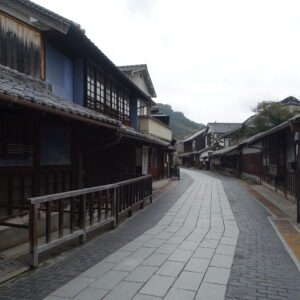
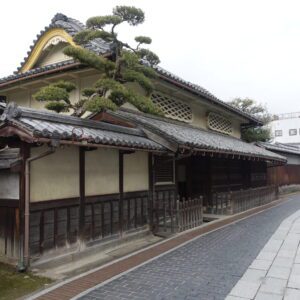
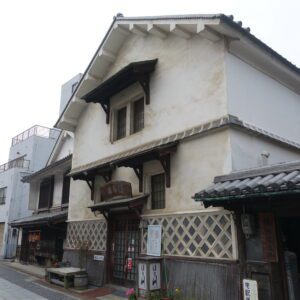
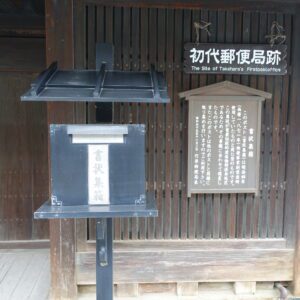
Even today, the streets of the Edo period still remain in Takehara, giving it a calm atmosphere. In particular, the good part of “Takehara Preservation District of Important Historical Buildings” is that the residents still live and preserve the cityscape.
The other Preservation Districts for Groups of Traditional Buildings is a noisy area with many souvenir shops and restaurants, but Takehara can take a quiet walk while remembering the streets of the Edo period.
There are few restaurants in the “Takehara Preservation District of Important Historical Buildings”, so it’s a good idea to shop, eat and drink at the nearby “Roadside Station”.

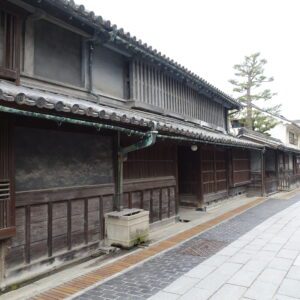

Jizo-do was worshiped as the guardian deity of the district when Takehara prospered in the salt farms during the Edo period. The current Jizo-do building was rebuilt in 1927.
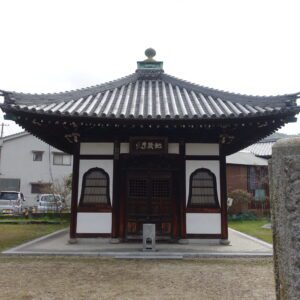
Takakage Kobayakawa built Furosan Chosei-ji Temple in 1587. The current main hall was built in 1962, and there are Kompira-sha, Daishido, and Koshindo in the precincts.
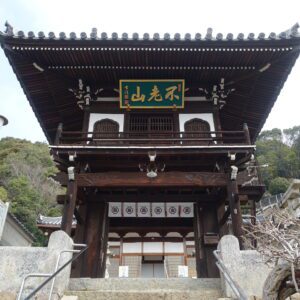
2. Taketsuru Sake Brewery
Taketsuru Sake Brewery is located in the “Takehara Preservation District of Important Historical Buildings”. The birthplace of Masataka Taketsuru, the founder of Nikka Whiskey and known as the “father of Japanese whiskey.” The whiskey “Taketsuru Pure Malt” is popular all over the world and is in short supply. I also love “Taketsuru Pure Malt” whiskey.
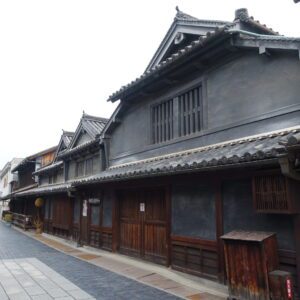
Taketsuru Sake Brewery is a long-established sake brewery founded in 1733, and still makes sake under the name of “Kosasa-ya”. The sake currently sold by Taketsuru Shuzo includes “Sake Taketsuru,” “Omachi Junmai Nigori,” and “Junmai Hiden.”
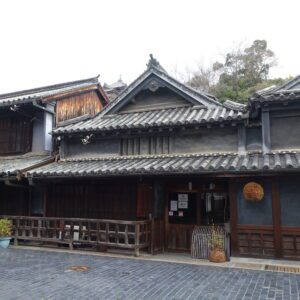
3. Shunpu-kan / Fukko-kan
There are two national important cultural properties in the “Takehara Preservation District of Important Historical Buildings”, Shunpu-kan and Fukko-kan.
“Shunpu-kan” was Rai Sanyo’s uncle and Rai Shunpu’s residence. After studying medicine and Confucianism in Osaka, Rai Shunpu returned to his hometown of Takehara to open a hospital and built the Shunpukan in 1781. The current building was rebuilt in 1855. Unfortunately, we cannot tour the inside.
Rai Sanyo is a historian, thinker, Chinese poet, and literary person in the late Edo period. His main work, “Nihon Gaishi,” influenced the Sonno Joi movement at the end of the Edo period. By the way, Rai Sanyo’s father, Shunsui, was born and raised in Takehara, but Rai Sanyo was born in Osaka and raised in Hiroshima, and does not live in Takehara.

“Fukko-kan” is a house built by Kozono, who was adopted by Rai Shunpu, in 1859 as a branch of Kozono’s son. It is adjacent to the west side of the Shunpu-kan. The current building was built in 1883.
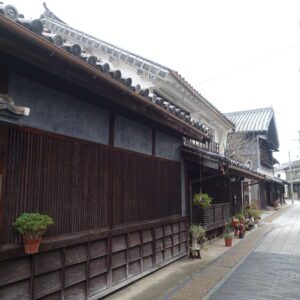
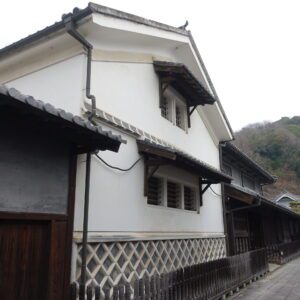
4. Onomichi Hondori Shopping Street
I went from “Roadside Station” in Takehara to Onomichi Station by public transportation. The public transportation I used is as follows.
Depart Roadside station Takehara at 10:40, Geiyo Bus “bound for Mihara sales office”, arrive at Mihara station at 11:41
Depart Mihara Station at 11:53, Sanyo Line “bound for Fukuyama”, arrive at Itozaki Station at 11:57
Depart Itozaki Station at 11:59, Sanyo Line “bound for Okayama”, arrive at Onomichi Station at 12:06, total fare Yen 1,280
After arriving at Onomichi Station, I had lunch and strolled at the Onomichi Hondori shopping street.
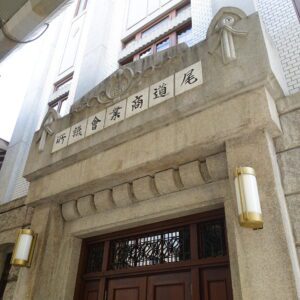
Onomichi Hondori Shopping Street is one of the longest shopping streets in Japan with a total length of about 1.2km, and there are about 210 stores along the shopping street. There are more than 10 long-established stores that have been in business for over 100 years, and it was fun to take a walk in the shopping district while looking at the old buildings.
However, it was a pity that many stores in Onomichi Hondori shopping street were closed as well as many shopping streets in Japan. It is a pity that even Onomichi, which has been very successful in attracting tourists, has become a shutter street (street with many closed-down shops).
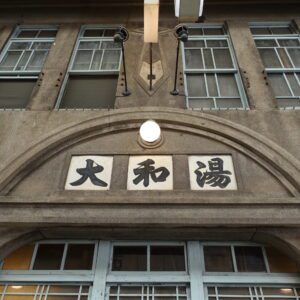
The former Onomichi City Branch Office, located on a street slightly off the Onomichi Hondori shopping street, was originally the Onomichi Branch of Sumitomo Bank. It was built in 1904.
Designed by Magoichi Noguchi, a disciple of Kingo Tatsuno who designed the Marunouchi station building at Tokyo Station and the Bank of Japan Head Office. Magoichi Noguchi designed the Osaka Prefectural Nakanoshima Library, which is an important cultural property of Japan. The former Onomichi City Branch Office features a very unique window stone design.
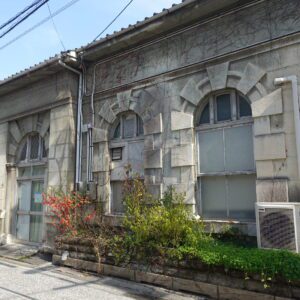
5. Tenneiji Temple
After enjoying a walk in the Onomichi Hondori shopping street, I went to Tenneiji Temple. Tenneiji Temple was founded in 1367. The second shogun, Yoshiakira Ashikaga, the son of Takauji Ashikaga, the first shogun of the Muromachi Shogunate, built a five-storied pagoda in 1388. The third shogun, Yoshimitsu Ashikaga, stayed at Tenneiji Temple in 1389 and it has a close relationship with the Ashikaga Shogunate.
To get to Tenneiji Temple, go through the railway viaduct and go up the stairs. You can see the running train in the immediate vicinity. The photo below shows the passage of a freight train.

Since the five-storied pagoda became obsolete in 1692, the upper two layers were removed to make it the current three-storied pagoda (about 20 m in height). The three-storied pagoda is a national important cultural property. The scenery seen from the slope above the three-storied pagoda is one of the representative scenery of Onomichi.
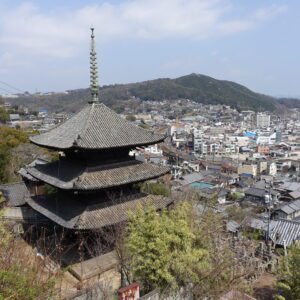
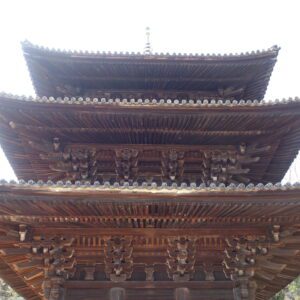 The gate of Tenneiji Temple and the main hall are wonderful, but the “Fusuma-e (Fusuma painting)” inside the main hall was a masterpiece.
The gate of Tenneiji Temple and the main hall are wonderful, but the “Fusuma-e (Fusuma painting)” inside the main hall was a masterpiece.
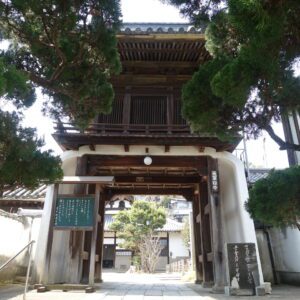
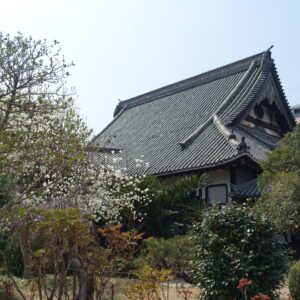
The peony and lion “Fusuma-e” are the work of Gyokusei Jikihara, an authority in the Japanese Nanga. I was overwhelmed by the vigorous painting of the lion.
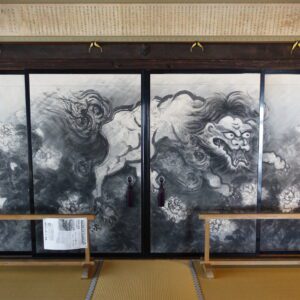
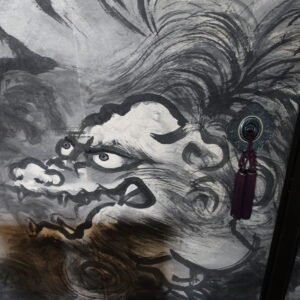
I was overwhelmed by the Statues of the 500 Rakans of Tenneiji Temple. Unlike the cute 500 Rakan wearing the red hat of Daishoin in Miyajima, which I went to the day before, the 500 Rakan of Tenneiji Temple had a solemn atmosphere.
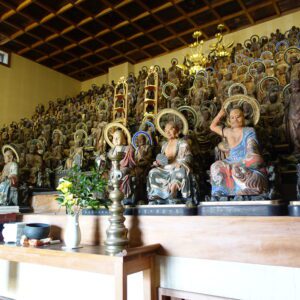
6. Saikokuji Temple
Next to Tenneiji Temple, I wanted to go to Joshoji Temple, which is a national important cultural property. But I gave up because it was undergoing a large-scale repair from 2016 and went to Saikokuji Temple. It is about a 15-minute walk from Tenneiji Temple.
According to the temple, Saikokuji Temple was built in 729 by Gyoki. This is the headquarters of the Shingon sect Daigo school. It became Emperor Shirakawa’s Chokuganji-temple (temple built at the order of the emperor) in 1108 and was proud of the biggest Buddhist temple in the Sanyo region. It is still the largest temple in Onomichi City.
Deva gate is an important cultural property designated by Hiroshima Prefecture. It was built in 1648. 2m large straw sandals are hung, hoping for good legs. I was quite surprised at the size of these large straw sandals.
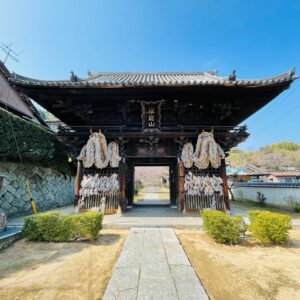
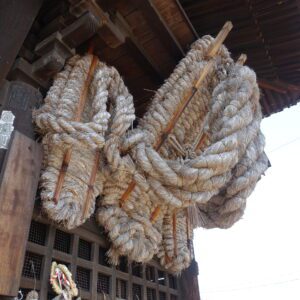
The Kondo, which was built in 1386 by Mr. Yamana, the guardian of Bingo, is designated as a national important cultural property. It remains so beautiful that it doesn’t look like it was built over 600 years ago.
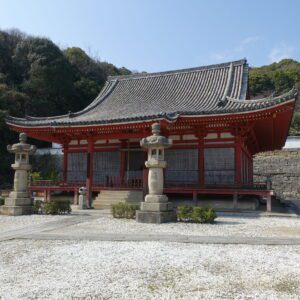
From the precincts of the Kondo and the bell tower, go up the stairs through the precincts of Daishido and Bishamonten, and you will find the three-storied pagoda.
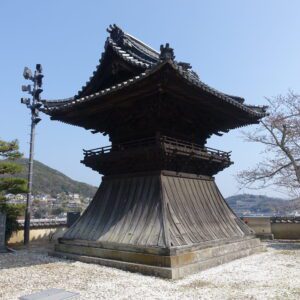
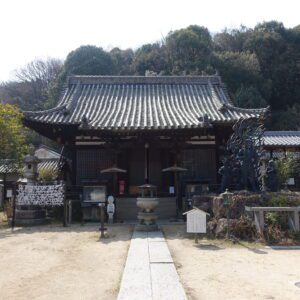

The three-storied pagoda was built in 1429 with the donation of Yoshinori Ashikaga, the sixth shogun of the Muromachi Shogunate. It has remained beautiful at the time of its construction without a fire. The three-storied pagoda is a national important cultural property. The view of Onomichi from the location of the three-storied pagoda is very beautiful.
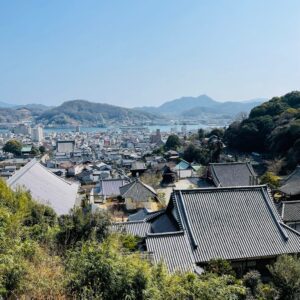
7. Saigoji Temple
Next to Saikokuji Temple, I went to Saigoji Temple, which is about a 10-minute walk away.
Saigoji Temple was built in 1353 with a donation from Takauji Ashikaga. The main hall best represents the architectural style of the Northern and Southern Dynasties, and is considered to be the remains of the oldest main hall of Ji-shu sect of Buddhism. The main hall and the temple gate are national important cultural properties.
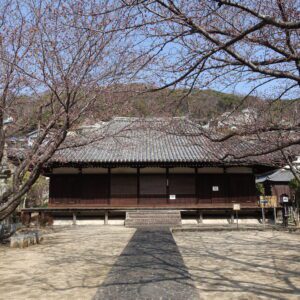
There is a Echo ceiling inside the main hall, but I couldn’t enter it inside the main hall.
Next to Saigoji Temple is the former Kubo Elementary School building built in 1933. The school closed at the end of March 2021 and marked the end of 88 years of history. It will be dismantled in the future.
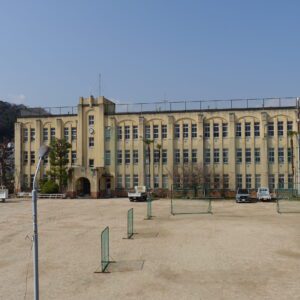
8. Jodoji Temple
Next, I went to Jodoji Temple, which is about a 10-minute walk from Saigoji Temple. Jodoji is a headquarters temple of Shingon sect Senyuji school. It is said that Prince Shotoku was founded in 616. It is also famous as a temple where Takauji Ashikaga prayed for victory during the battles of Kyushu Campaign and Minatogawa.
The main hall and Tahoto (two-storied pagoda) of Jodoji Temple are national treasures.
The main hall was built in 1327 and is a masterpiece of medieval Setchuyo Buddhist temple architecture. Setchuyo style is an eclectic style of Japanese style architecture, Daibutsu style architecture, and Zenshu style architecture. The main hall of Kakurinji Temple (national treasure, built in 1397) in Hyogo Prefecture is also a masterpiece of Setchuyo Buddhist temple architecture, just like the main hall of Jodoji Temple. The first photo is the main hall of Jodoji, and the second photo is the main hall of Kakurinji.
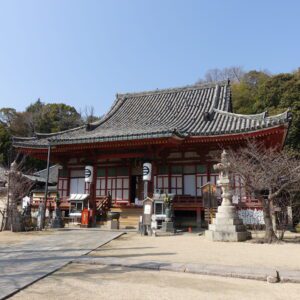
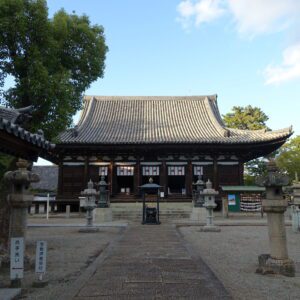
The Tahoto (two-storied pagoda) was built in 1328. As a Tahoto, it is one of the six national treasures in Japan as Tahoto. The form of the Tahoto is different from the five-storied pagoda and the three-storied pagoda, and is unique to Japan. The Tahoto is a tower in which the first layer with a square plane and the upper layer with a circular plane are layered.
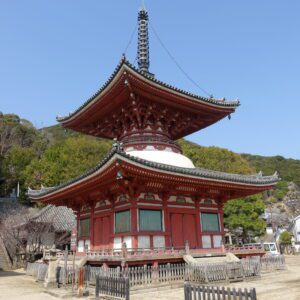
Jodoji Temple has many national important cultural properties such as temple gate and Amida-do (temple hall containing an enshrined image of Amitabha).
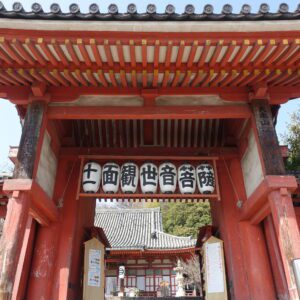
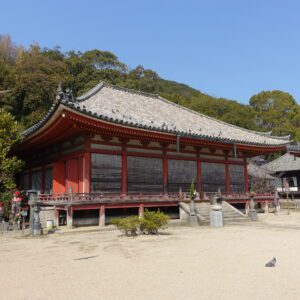
It is said that homing pigeons were kept at the “Uramon (back gate)” during the Edo period, and there are still many pigeons in the precincts. You can also buy pigeon food for Yen 30 and give it to the pigeon. Although it is a wild pigeon, when you put food on your hands, the pigeon is so accustomed to people that it stays on your hands and shoulders. The “Uramon” is also a national important cultural property.
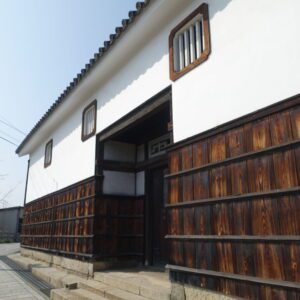
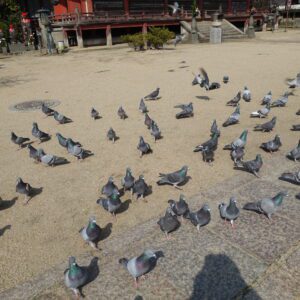
The approach to Jodoji Temple is similar to the approach to Tenneiji Temple, and it goes through the railway viaduct. The sea is very close and it is a nice view.
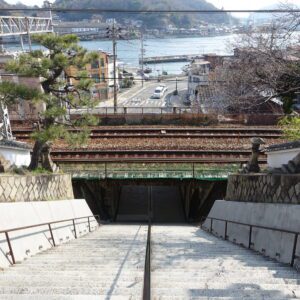
Jodoji Temple has many national treasures and national important cultural properties, so it was a lot of fun to walk around the precincts. However, since it is a 30-minute walk from Onomichi Station, there were no other tourists. Jodo-ji is a remote place, but I think it is a temple that is well worth visiting.
9. Fukuyama Castle
After being satisfied with walking around Onomichi, I took a train to Fukuyama Station. The trains I used are as follows.
Depart Onomichi Station at 15:44, Sanyo Line “bound for Himeji”, arrive at Fukuyama Station at 16:04, fare Yen 420
When you arrive at Fukuyama Station, you can see Fukuyama Castle from Platform 6. However, the castle tower (inside the Fukuyama Castle Museum) has been closed for a long time until August 27, 2022 due to a large-scale renovation. The castle tower was rebuilt in 1966 with a reinforced concrete structure.
The Fushimi turret on the left side of the platform of Fukuyama station is a three-story corner turret. It was relocated in 1620 from the eastern turret of Matsunomaru, Fushimi Castle in Kyoto, which is estimated to have been built around 1601. When Katsunari Mizuno built Fukuyama Castle, Hidetada, the second shogun of Tokugawa, relocated it. The Fushimi turret is one of the oldest surviving turrets along with the Kumamoto Castle Uto turret.
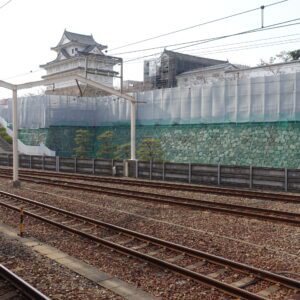
I always wonder, how was the relocation of buildings during and before the Edo period? The distance between Kyoto and Fukuyama is about 260km. I think that new construction will require less effort than relocation. How did the people at that time carry the dismantled timber and roof tiles over a distance of 260km?
In the 1945 Fukuyama air raid, the area around the Fushimi turret escaped fire and became the only existing turret in Fukuyama Castle. It is designated as a national important cultural property.
The Tsukimi turret, which can be seen on the right side of the platform of Fukuyama Station, was reconstructed in 1966 with reinforced concrete at the same time as the castle tower. The interior is used as a rental venue for tea parties.
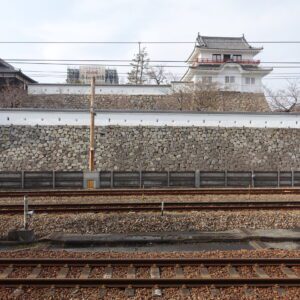
At the Bara (Rose) Park Exit (South Exit) of Fukuyama Station, there is a statue of an angler named “Izura Chojin”. It was created in 1975 to commemorate the opening of the Shinkansen at Fukuyama Station. It is a work of Denchu Hirakushi, a sculptor representing modern Japan. Denchu Hirakushi is an honorary citizen of Fukuyama City because he grew up in Fukuyama City.

Note: The departure / arrival times, fares of transportation, admission fees, meal fees, etc. listed in the text are as of the time of writing the BLOG. Please check for yourself when you go on a trip as it may change in the future.